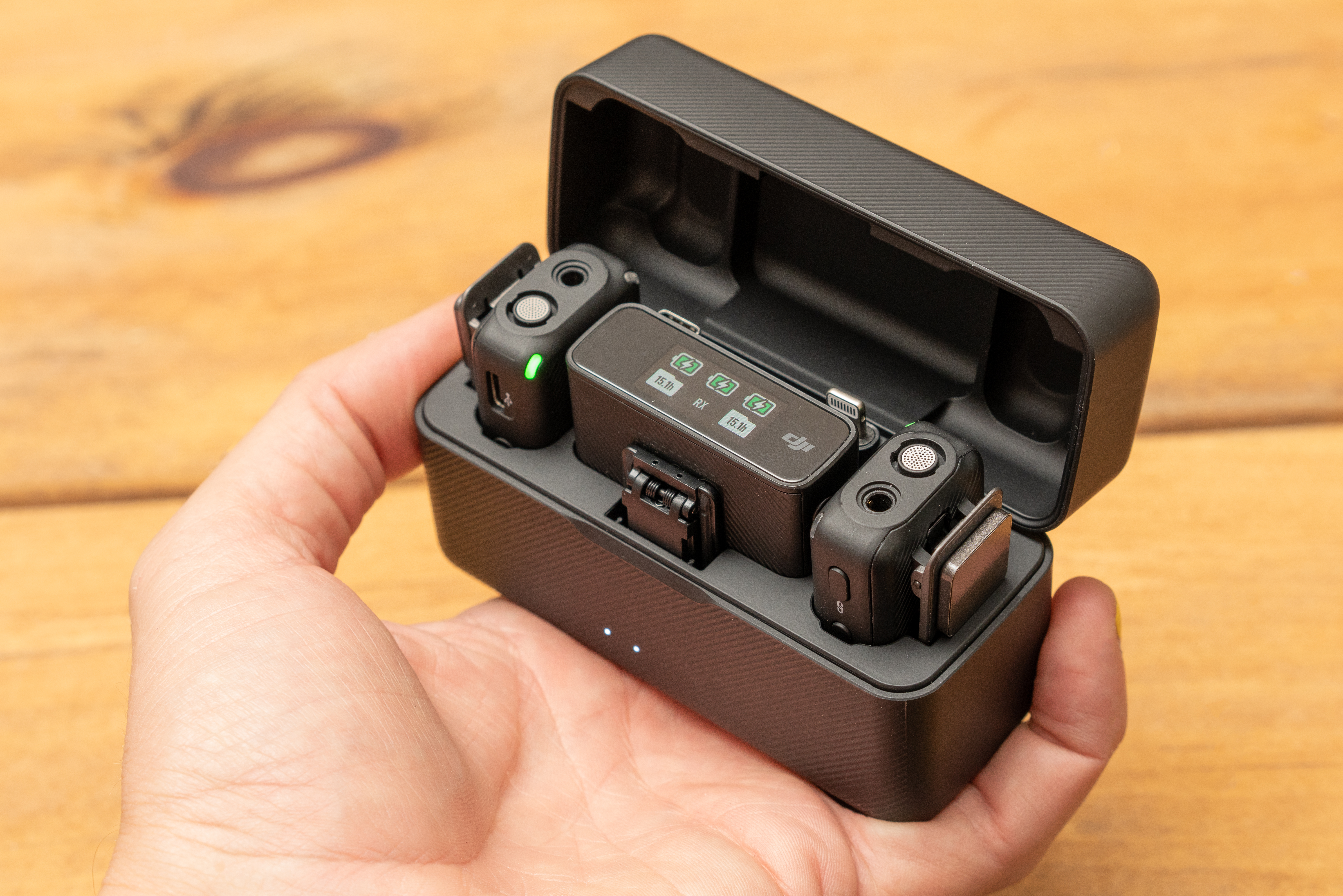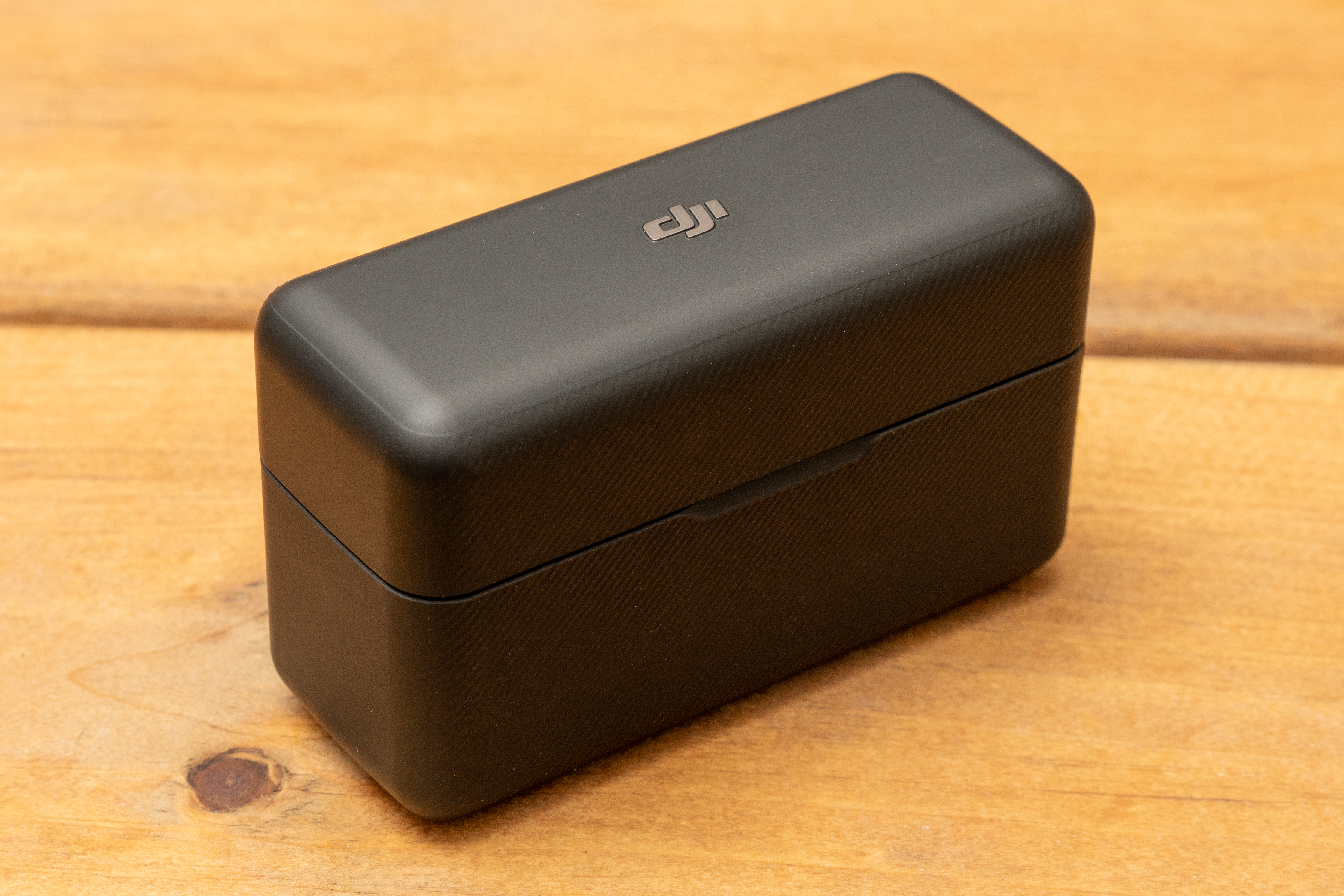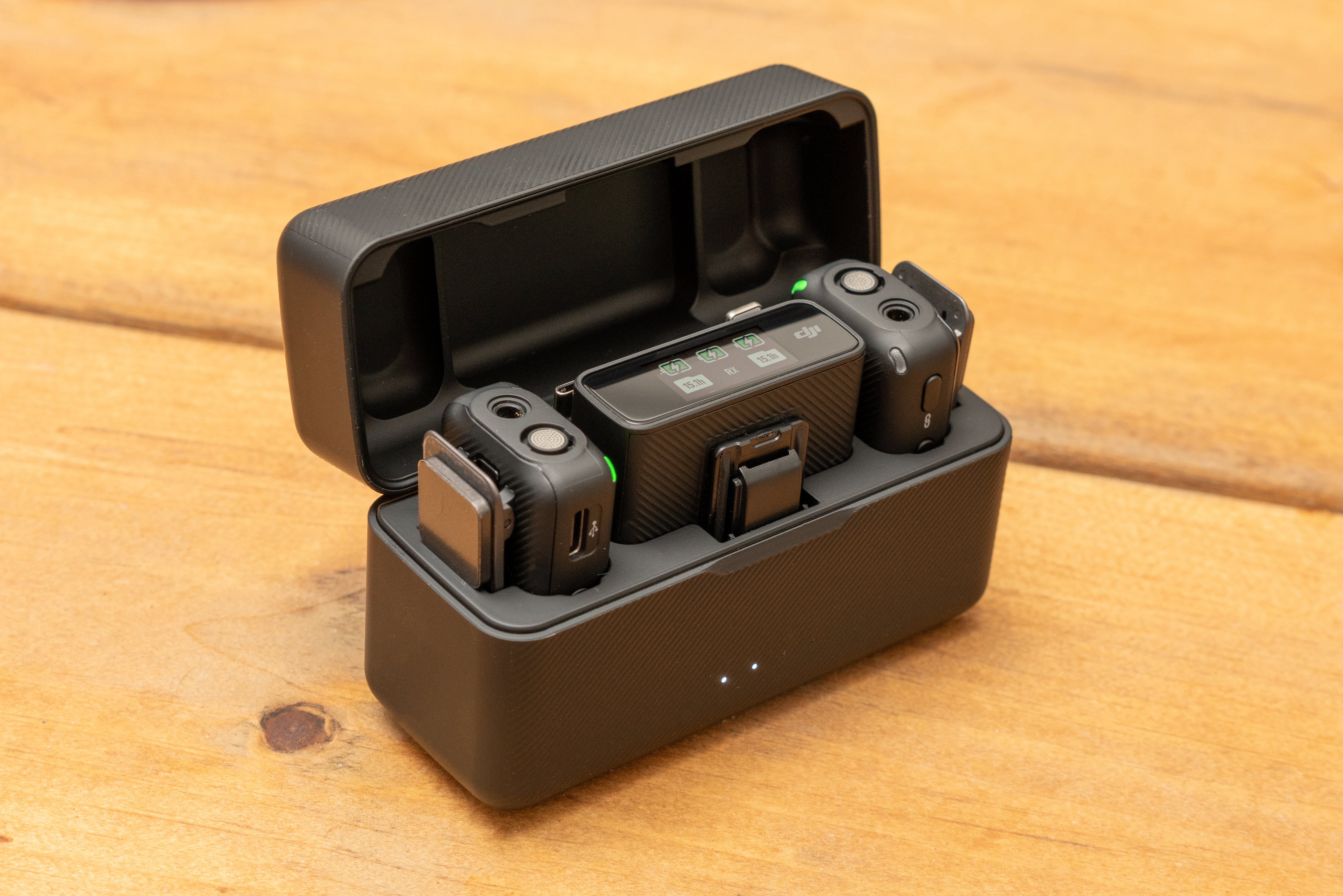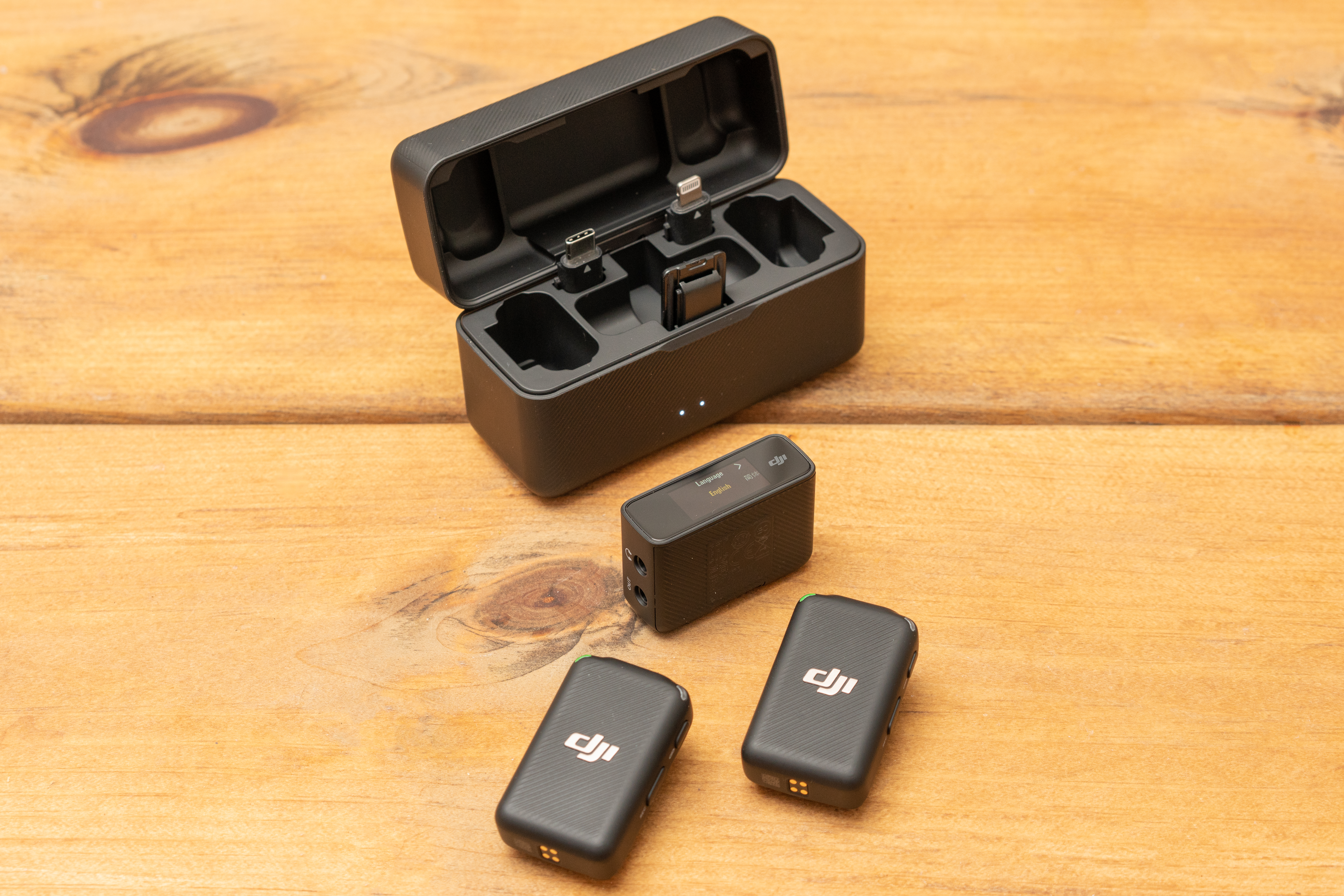I got really excited about the DJI Mic announcement a couple of weeks ago, and concluded that, at least on paper, it’s the perfect companion for vloggers and on-the-go media creators. As is often the case, once we look beyond the hype things are a tiny bit more complicated than that. Overall, it may very well be a good and elegant solution for the right audience, but it isn’t as much of a slam dunk as you’d think.
The charger case is extraordinarily well built. The lid closes with a satisfying clunk, and the two transmitters, the receiver and the USB-C and Lighting adapters for the receiver are all securely ensconced in the charger case. Battery life is extraordinary, and the range of the microphones never gave me any issues in testing, so all of that was reassuring.
I did note the size when I first took the DJI Mic out of its packaging. On closer reflection, it makes sense that two microphones, a receiver and a bunch of clips and adapters are bigger and heavier than a set of headphones, and the whole kit does fit comfortably in a pocket, but when you slip it into your jeans, there’s no risk of not realizing they are there. The kit weighs in at a hefty 260 grams (9.2 oz). While DJI describes its size as a packet of cigarettes — those are some heavy-ass, weird-shaped cigarettes.

The DJI Mic charging case is a lot bigger than I originally expected based on the press images from DJI. Image Credit: Haje Kamps for TechCrunch(opens in a new window)
I can’t complain about the form factor of the device too much; if it did what it promised, it would be worthy of a permanent place in my video bag any day. This is where the situation gets a little sticky.

The charger case is exceptionally well built, and I’d drop it into a camera bag without a second thought.
The main issue is with the lavalier clip-on microphones themselves. They look fantastic, and they are ridiculously easy to set up and use, but ultimately the only thing that truly matters is how good the sound quality is, and that’s where things get a little more complicated.
When you talk directly into the microphone at point-blank distance, the audio is great, so if you use the mics as small hand-held microphones, you’re in for a treat. However, that’s not really how they are designed — you’re meant to clip them on to a shirt, either with the built-in clip or with the included magnets. The clips are sturdy and the magnets work great, but I was never quite able to position them in such a way that they picked up my voice well. It’s as if I’m always talking past the mics rather than into them.
The microphone transmitters are small, yes, but they are not quite small enough for you to comfortably place them exactly where they are needed. Each microphone transmitter does have a 3.5mm socket where you can plug in a proper, light-weight lavalier microphone which is easier to position, but at that point, I’m left scratching my head whether the setup still makes sense: the all-you-need-in-a-box nature of the DJI Mic is part of its charm, and having to add additional external microphones feels a little bit like the DJI product team had an extraordinary idea, but were unable to fully execute on its vision.

Snugly in its charger case, the microphones and receiver will happily charge until you are ready for them.
I’m struggling to really figure out how to review the DJI Mic, if I’m being really honest. At $329, there are no real competitors worth speaking of. If you like to film from a distance beyond a few feet, these little microphones are going to be better than the on-camera microphone by quite some considerable margin. The incredible ease of use and nigh-on foolproof operation means that you don’t really need to look at the operation manual either: Plug the receiver in, hand your interviewee a microphone and you’re good to go.
The question is whether it’s high-end enough. Yes, it’s better than nothing, and a set of Sennheiser wireless lavs with the receiver will set you back twice, if not three times what you pay for the DJI Mic.

Here, you can see the two microphones and the receiver — the microphones are larger than you’d think, the receiver was surprisingly small. In the case, you can see the Lightning and USB-C adapters for connecting the receiver to your phone. The receiver also has a line out, so you can connect it to pretty much any recorder or camera on the market today.
What it really boils down to is how professional your aspirations are. If you want top-shelf audio to go with your video recordings, you can buy a pair of wired lavalier mics and a really long extension cable for $50 or less. Then you can position them exactly where you need them, and you don’t have to worry about running out of range or batteries. Less convenient, for sure, but higher quality. If you love the convenience of wireless and want higher quality, there are better options available out there.
Let’s compare and contrast
If you want to dive into the deep geek, I compared a few different microphones in exactly the same sound landscape (my office with the door to the outside open to get some road noise in there). First up is the DJI Mic clipped to my shirt. As you can hear, it’s a little bit tinny, picks up a fair amount of road noise and I don’t love the overall sound. The second clip is the same microphone, but I’m holding it about three inches from my mouth, and I’m speaking straight into it. The quality is markedly better — and if I’m being honest, this was what I was hoping for when I started reviewing the DJI Mic microphones. The third clip is what it sounds like when I speak straight into my Google Pixel 6 Pro’s built-in microphones. It sounds god-awful; the audio is clipped, it picks up a ton of background noise, and I think it sounds really tinny and unpleasant.
The fourth clip is shot with the Røde VideoMic Me — it’s my go-to microphone when I’m interviewing and doing audio notes in crowded places. Not perfect, but makes it really easy to understand the interviewee. I’d say the quality is comparable with the DJI Mic when I speak straight into the microphone, but the VideoMic is even less hassle, and costs $70 or so. Obviously, the VideoMic has more of a directional boom mic feel, so it’s a very different piece of kit than the lavalier-style microphone of the DJI Mic. The last sample is an Audio-Technica AT2005 USB microphone plugged into my computer. This microphone costs around $60, but is by far the best-sounding mic of the lot. It’s a very different type of microphone again, of course — a cardioid dynamic microphone — which can’t be used as a small, subtle, hidden microphone the way the DJI Mic can — but if you’re optimizing for quality and you can deal with your interviewee hand-holding a microphone, it might be the best way to get high-quality sound.
Ultimately, I struggle to figure out who the DJI Mic is truly for; it’s good but not great. It’s affordable but not cheap. It wants to weasel its way into your heart and your camera bag, but I’m resisting its charms. It’s as if it’s trying to be the super-convenient jack-of-all-trades, but in the process, I’m finding it is the master of none, and for every recording situation where the DJI Mic is a good option, there are either better, less convenient, cheaper options or far better, more expensive options available.
If you need convenience and speed and ease of setup above all, you can make the argument for this setup. If you’re spending someone else’s money, you can argue that you saved $700 on not buying a set of Sennheiser wireless lavs. If you’re traveling as light as possible and that’s more important than audio quality, the DJI Mic might just hit the sweet spot. For every other use case, it’s a pretty confusing product; I’d be surprised if it finds a huge mainstream following.
Having said all of that — DJI also launched an action cam that was essentially a spin-off of its drone tech, and it turned out to be fantastically successful and found a cult following. The company has deep pockets and this is its first volley; I wouldn’t be surprised if version 2 irons out the teething problems and it may very well find itself with a winner on its hands.





More Stories
11+ Best ThePiratebay3 Sites – Ultimate Pirate bay Alternatives
7movierulz iBomma – 11 Best Alternatives to Download & Watch latest Telugu Movies
How to Spam a Phone Number (7 best apps & services) with call, texts to Get Revenge?